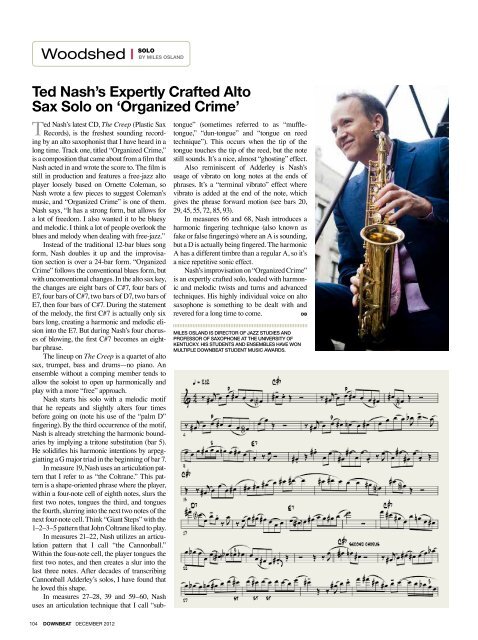Ron Carter Esperanza Spalding - Downbeat
Ron Carter Esperanza Spalding - Downbeat
Ron Carter Esperanza Spalding - Downbeat
You also want an ePaper? Increase the reach of your titles
YUMPU automatically turns print PDFs into web optimized ePapers that Google loves.
solo<br />
Woodshed | By miles osland<br />
Ted Nash’s Expertly Crafted Alto<br />
Sax Solo on ‘Organized Crime’<br />
Ted Nash’s latest CD, The Creep (Plastic Sax<br />
Records), is the freshest sounding recording<br />
by an alto saxophonist that I have heard in a<br />
long time. Track one, titled “Organized Crime,”<br />
is a composition that came about from a film that<br />
Nash acted in and wrote the score to. The film is<br />
still in production and features a free-jazz alto<br />
player loosely based on Ornette Coleman, so<br />
Nash wrote a few pieces to suggest Coleman’s<br />
music, and “Organized Crime” is one of them.<br />
Nash says, “It has a strong form, but allows for<br />
a lot of freedom. I also wanted it to be bluesy<br />
and melodic. I think a lot of people overlook the<br />
blues and melody when dealing with free-jazz.”<br />
Instead of the traditional 12-bar blues song<br />
form, Nash doubles it up and the improvisation<br />
section is over a 24-bar form. “Organized<br />
Crime” follows the conventional blues form, but<br />
with unconventional changes. In the alto sax key,<br />
the changes are eight bars of C#7, four bars of<br />
E7, four bars of C#7, two bars of D7, two bars of<br />
E7, then four bars of C#7. During the statement<br />
of the melody, the first C#7 is actually only six<br />
bars long, creating a harmonic and melodic elision<br />
into the E7. But during Nash’s four choruses<br />
of blowing, the first C#7 becomes an eightbar<br />
phrase.<br />
The lineup on The Creep is a quartet of alto<br />
sax, trumpet, bass and drums—no piano. An<br />
ensemble without a comping member tends to<br />
allow the soloist to open up harmonically and<br />
play with a more “free” approach.<br />
Nash starts his solo with a melodic motif<br />
that he repeats and slightly alters four times<br />
before going on (note his use of the “palm D”<br />
fingering). By the third occurrence of the motif,<br />
Nash is already stretching the harmonic boundaries<br />
by implying a tritone substitution (bar 5).<br />
He solidifies his harmonic intentions by arpeggiatting<br />
a G major triad in the beginning of bar 7.<br />
In measure 19, Nash uses an articulation pattern<br />
that I refer to as “the Coltrane.” This pattern<br />
is a shape-oriented phrase where the player,<br />
within a four-note cell of eighth notes, slurs the<br />
first two notes, tongues the third, and tongues<br />
the fourth, slurring into the next two notes of the<br />
next four-note cell. Think “Giant Steps” with the<br />
1–2–3–5 pattern that John Coltrane liked to play.<br />
In measures 21–22, Nash utilizes an articulation<br />
pattern that I call “the Cannonball.”<br />
Within the four-note cell, the player tongues the<br />
first two notes, and then creates a slur into the<br />
last three notes. After decades of transcribing<br />
Cannonball Adderley’s solos, I have found that<br />
he loved this shape.<br />
In measures 27–28, 39 and 59–60, Nash<br />
uses an articulation technique that I call “subtongue”<br />
(sometimes referred to as “muffletongue,”<br />
“dun-tongue” and “tongue on reed<br />
technique”). This occurs when the tip of the<br />
tongue touches the tip of the reed, but the note<br />
still sounds. It’s a nice, almost “ghosting” effect.<br />
Also reminiscent of Adderley is Nash’s<br />
usage of vibrato on long notes at the ends of<br />
phrases. It’s a “terminal vibrato” effect where<br />
vibrato is added at the end of the note, which<br />
gives the phrase forward motion (see bars 20,<br />
29, 45, 55, 72, 85, 93).<br />
In measures 66 and 68, Nash introduces a<br />
harmonic fingering technique (also known as<br />
fake or false fingerings) where an A is sounding,<br />
but a D is actually being fingered. The harmonic<br />
A has a different timbre than a regular A, so it’s<br />
a nice repetitive sonic effect.<br />
Nash’s improvisation on “Organized Crime”<br />
is an expertly crafted solo, loaded with harmonic<br />
and melodic twists and turns and advanced<br />
techniques. His highly individual voice on alto<br />
saxophone is something to be dealt with and<br />
revered for a long time to come. DB<br />
Miles Osland is Director of Jazz Studies and<br />
Professor of Saxophone at the University of<br />
Kentucky. His students and ensembles have won<br />
multiple DownBeat Student Music Awards.<br />
104 DOWNBEAT DECEMBER 2012
















